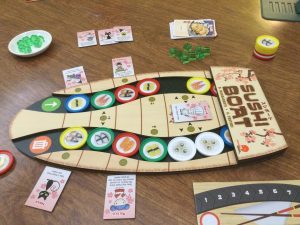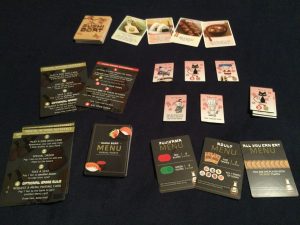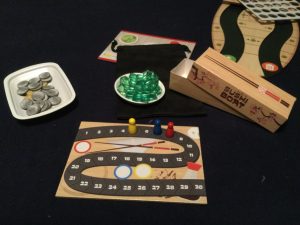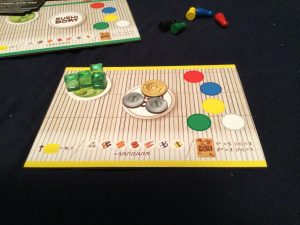| Publisher | Japanime Games |
| Design Credits | Dario Massarenti, Francesco Testini |
| Art Credits | kokozu, Even Kwan, Elaine Schimek |
| Editing Credits | William Niebling |
| Game Contents | Wooden Sushi Boat board, 54 Plates (12 each in four colors and six white), cloth bag, 36 Wasabi cubes, ceramic Wasabi Bowl, eight Staff tiles, 55 cards (26 Side Dishes, four Wasabi, 20 Menus, five reference cards), five player mats, five pawns, 30 Yen coins (five five-Yen gold coins and 25 one-Yen silver coins), scoring track, change tray, Chopstick Box, Sushi Boat sampler (informative flyer re: Japanese sushi cuisine terms) rules |
| Guidelines | Japanese cuisine set collection game |
| MSRP | $64.95 |
| Reviewer | Andy Vetromile |
For those unfamiliar with the term, a sushi boat is a wooden serving dish used in Japanese restaurants to present the food to the table. They are so named for their resemblance to watercraft, laden with various meal elements and condiments. Japanime Games has made this feature the centerpiece of their morsel-rich game Sushi Boat.
The object is to score the most points.
Two to five diners sit down for a big tuck at their local sushi restaurant and watch as dishes rotate past them. Like many such fine establishments, the food is on a Conveyor Belt and one simply picks up the item one wants as it drifts past. The Sushi Boat has a little track and the Plates, small plastic devices with pictures of the repasts, slide along as new meals are placed at the beginning of the route. This also means some dishes eventually fall off the far end and into the Trash (a perhaps poorly named discard position, given the possibility a player might later rescue desired food from said pile).
On their turn a player puts their pawn on a space adjacent to the conveyor, preferably beside a Plate they seek to collect. If a Staff member is also in attendance they can be tipped a Yen for an advantage like snagging out-of-reach Plates, pulling dishes from the garbage (eww), or grabbing extra Wasabi. By eating the sushi in front of them the player adds it to the stack on their player mat. These score points based on gathering like colors (multiple blues, say) or different meal types. Sushi Boat has two memory components, the first being what foods you’ve eaten – you can’t go through your stack to check so hopefully you can assemble a set of the seven dishes from recall.
Then there are the Wasabi Challenges, which pop up out of the deck at random. At that point diners must try to remember what color dishes disappeared into the little tunnel on the game’s titular Sushi Boat. Correct guesses net you Wasabi cubes, worth points at game’s end. Also performing double duty is the Side Dishes deck. Not only does it serve as the game’s timer – one card is pulled each turn to indicate how far the conveyor moves the goods along – the active player may also buy the topmost discard to use its ability. These may assign additional VPs, allow a player to manipulate his Plate stack, or improve one’s odds during a Wasabi Challenge. When the deck runs out the game is over and the highest score wins.
It could fail on the strength of its biggest component alone – when you call a game Sushi Boat you’d better be able to deliver – but fortunately it does not (fail, that is; it does deliver). The “dish” is a powerhouse item, a well-crafted wooden board with a Conveyor Belt groove to smoothly allow Plates to slide along, and even under, the playing surface (and to fall off the end). The illustrations and graphics are lush (for the food) and traditional (for the anime characters), and almost everything is sturdy. One notable exception: The Plates come tightly packed in plastic and separating them takes some doing – which may also loosen their pictures. Each has a little “bubble sticker” of its food (think the consistency of the popular googly eyes novelty items) and those can detach (either while unboxing or in a warm car – it’s not clear which). Then again they seem to readhere with little difficulty, too. Over time, their longevity is anyone’s guess. The Wasabi Bowl appears to be honest-to-goodness ceramic and the plastic change dish looks for all the world identical to the ones you get your bill on at local eateries. It has a spacious cloth bag for the Plates, translucent plastic green cubes for the wasabi, and good cards and cardboard for most everything else. There’s even a perhaps-pointless but still-useful little Chopstick Box to assist in parts storage though its stock is thin. The insert doesn’t stop the Plates from rolling about loose in the box in transit to your game but it is an impressive piece of molding.
The ”guess the missing dish from memory” mechanic is pretty simplistic, beneath any serious gamer, until you actually have to do it. When confronted with the animal itself the memory component serves as a reminder (ahem) that the thing you take for granted is what does you in. Trying to keep up with what just went under the little tunnel is harder than it looks given you can’t watch it constantly. It moves all the time and even if opponents announce they’re shifting things it’s a lot of transition to keep track of. You could establish a gentleman’s agreement to declare when you push food on the belt but this simply adds to Sushi Boat‘s memory issues since you must now remember to say when you’re doing it.
One would think from the description of the more mundane aspects of Sushi Boat there’s no innovation here – few of the mechanics are what could be called “groundbreaking” – but Japanime Games still manages to make a meal out of it. The set collection element can be interrupted by so many things, and there’s no end of paths leading to a potential victory. Even if the basic game, which demands a well-balanced diet from its players, wears thin it offers Menu cards so everyone has secret aims to pursue (like having the most Wasabi cubes at the end of the game or gathering at least three California rolls). Now you’re confronted by all manner of new choices to reach those goals. This could result in players making a flurry of mad, wanton purchases (especially at game’s end) hoping for a Menu they’ve already coincidentally completed but it also offers a new way to spend Yen. Sushi Boat, like a fine meal, is a fun and easy way to pass your evening, and you certainly know what food to partner it with to make it a party.



